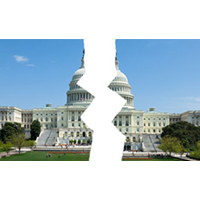As Republicans Drift Right, Gap between House and Senate is Greatest Since at least World War I
 (graphic: Steve Straehley, AllGov)
(graphic: Steve Straehley, AllGov)
The political gridlock that has largely paralyzed Washington is about more than Democrats and Republicans not seeing eye-to-eye. It’s also a result of the two houses of Congress being very far apart on the ideological scale.
According to Harry Enten at FiveThirtyEight, the House and Senate “are more divided than at any time since the end of World War I” as far as political viewpoints go.
Enten came to this conclusion after crunching some numbers and examining where representatives and senators fall on the liberal-conservative spectrum. The most conservative point on the scale used in the analysis is a +1, and the most liberal point is a -1.
Prior to the current period of extreme partisanship, the widest ideological gap on Capitol Hill came in the 1980s, when Democrats controlled the House and Republicans the Senate. Then, the numeric divide measured 0.2. Today the gap is more than double that, measuring 0.47 between the House and Senate.
“What is causing this yawning split between the House and Senate?” Enten wrote. “For one, this is only the seventh time since World War I where one party controlled the House and another the Senate. But that’s not all of it.”
Furthermore, he said: “When we contrast the two bodies, we see that the House is slightly more conservative at 0.27 than the Senate is liberal at -0.20. That fits with the idea that polarization is “asymmetric,” with House Republicans more responsible [for the divide] than Senate Democrats, but it’s clear that the median member of both chambers is closer to the poles than they usually are. The median House member in the current Congress is the fourth-most conservative out of 49 Congresses since the end of World War I. The median senator is tied for the fourth-most liberal.”
-Noel Brinkerhoff
To Learn More:
The House And Senate Are the Most Divided They’ve Been in Our Lifetimes (by Harry Enten, FiveThirtyEight)
In California, Democrats and Republicans are Farthest Apart; In Louisiana, there is Barely a Difference (by Ken Broder, AllGov)
Republicans Drifting more and more to the Right While Democrats Remain the Same (by Noel Brinkerhoff and David Wallechinsky, AllGov)
- Top Stories
- Unusual News
- Where is the Money Going?
- Controversies
- U.S. and the World
- Appointments and Resignations
- Latest News
- Trump to Stop Deportations If…
- Trump Denounces World Series
- What If China Invaded the United States?
- Donald Trump Has a Mental Health Problem and It Has a Name
- Trump Goes on Renaming Frenzy






Comments